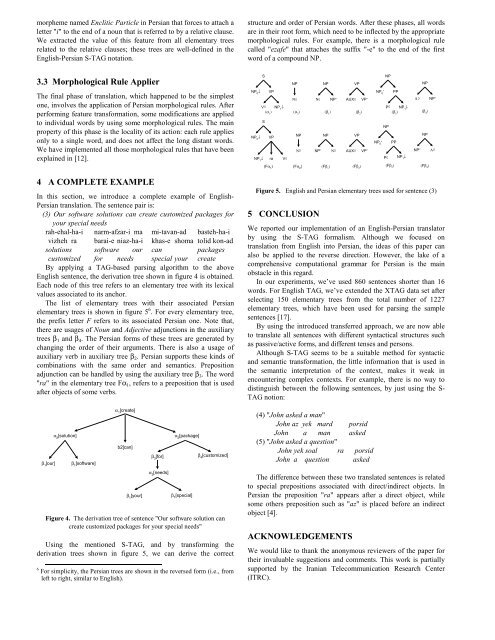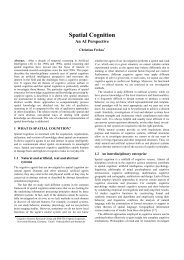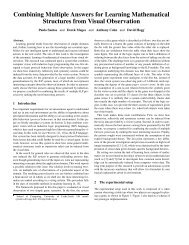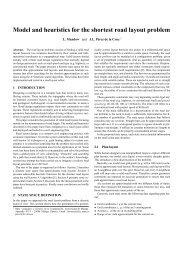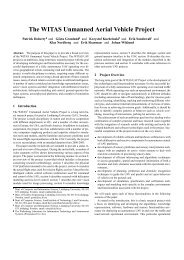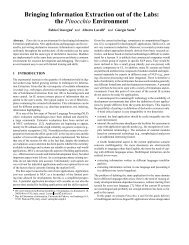An Application of Lexicalized Grammars in English ... - CiteSeerX
An Application of Lexicalized Grammars in English ... - CiteSeerX
An Application of Lexicalized Grammars in English ... - CiteSeerX
Create successful ePaper yourself
Turn your PDF publications into a flip-book with our unique Google optimized e-Paper software.
morpheme named Enclitic Particle <strong>in</strong> Persian that forces to attach aletter "i" to the end <strong>of</strong> a noun that is referred to by a relative clause.We extracted the value <strong>of</strong> this feature from all elementary treesrelated to the relative clauses; these trees are well-def<strong>in</strong>ed <strong>in</strong> the<strong>English</strong>-Persian S-TAG notation.structure and order <strong>of</strong> Persian words. After these phases, all wordsare <strong>in</strong> their root form, which need to be <strong>in</strong>flected by the appropriatemorphological rules. For example, there is a morphological rulecalled "ezafe" that attaches the suffix "-e" to the end <strong>of</strong> the firstword <strong>of</strong> a compound NP.3.3 Morphological Rule ApplierSNPNPVPNPNPThe f<strong>in</strong>al phase <strong>of</strong> translation, which happened to be the simplestone, <strong>in</strong>volves the application <strong>of</strong> Persian morphological rules. Afterperform<strong>in</strong>g feature transformation, some modifications are appliedto <strong>in</strong>dividual words by us<strong>in</strong>g some morphological rules. The ma<strong>in</strong>property <strong>of</strong> this phase is the locality <strong>of</strong> its action: each rule appliesonly to a s<strong>in</strong>gle word, and does not affect the long distant words.We have implemented all those morphological rules that have beenexpla<strong>in</strong>ed <strong>in</strong> [12].NP 0 ↓ VPNP 1 ↓V◊(α 1 )SNP 0 ↓ VPNP 1 ↓ ra(Fα 1 )(α 2 )Ν◊Ν◊NP ∗(β 1 )AUX◊VP ∗(β 2 )VPAUX◊VP ∗(Fβ 2 )4 A COMPLETE EXAMPLEIn this section, we <strong>in</strong>troduce a complete example <strong>of</strong> <strong>English</strong>-Persian translation. The sentence pair is:(3) Our s<strong>of</strong>tware solutions can create customized packages foryour special needsrah-ehal-ha-i narm-afzar-i ma mi-tavan-ad basteh-ha-ivizheh ra barai-e niaz-ha-i khas-e shoma tolid kon-adsolutions s<strong>of</strong>tware our can packagescustomized for needs special your createBy apply<strong>in</strong>g a TAG-based pars<strong>in</strong>g algorithm to the above<strong>English</strong> sentence, the derivation tree shown <strong>in</strong> figure 4 is obta<strong>in</strong>ed.Each node <strong>of</strong> this tree refers to an elementary tree with its lexicalvalues associated to its anchor.The list <strong>of</strong> elementary trees with their associated Persianelementary trees is shown <strong>in</strong> figure 5 6 . For every elementary tree,the prefix letter F refers to its associated Persian one. Note that,there are usages <strong>of</strong> Noun and Adjective adjunctions <strong>in</strong> the auxiliarytrees β 1 and β 4 . The Persian forms <strong>of</strong> these trees are generated bychang<strong>in</strong>g the order <strong>of</strong> their arguments. There is also a usage <strong>of</strong>auxiliary verb <strong>in</strong> auxiliary tree β 2 . Persian supports these k<strong>in</strong>ds <strong>of</strong>comb<strong>in</strong>ations with the same order and semantics. Prepositionadjunction can be handled by us<strong>in</strong>g the auxiliary tree β 3 . The word"ra" <strong>in</strong> the elementary tree Fα 1 , refers to a preposition that is usedafter objects <strong>of</strong> some verbs.Figure 5. <strong>English</strong> and Persian elementary trees used for sentence (3)V◊NP(Fα 2 )Ν◊NPNP ∗ (Fβ 1 )Ν◊NP ∗0 PPNP 1 ↓P◊(β 3 )NPNP ∗0 PPP◊NP 1 ↓(Fβ 3 )Α◊NP ∗(β 4 )NPNP ∗ (Fβ 4 )Α◊5 CONCLUSIONWe reported our implementation <strong>of</strong> an <strong>English</strong>-Persian translatorby us<strong>in</strong>g the S-TAG formalism. Although we focused ontranslation from <strong>English</strong> <strong>in</strong>to Persian, the ideas <strong>of</strong> this paper canalso be applied to the reverse direction. However, the lake <strong>of</strong> acomprehensive computational grammar for Persian is the ma<strong>in</strong>obstacle <strong>in</strong> this regard.In our experiments, we’ve used 860 sentences shorter than 16words. For <strong>English</strong> TAG, we’ve extended the XTAG data set afterselect<strong>in</strong>g 150 elementary trees from the total number <strong>of</strong> 1227elementary trees, which have been used for pars<strong>in</strong>g the samplesentences [17].By us<strong>in</strong>g the <strong>in</strong>troduced transferred approach, we are now ableto translate all sentences with different syntactical structures suchas passive/active forms, and different tenses and persons.Although S-TAG seems to be a suitable method for syntacticand semantic transformation, the little <strong>in</strong>formation that is used <strong>in</strong>the semantic <strong>in</strong>terpretation <strong>of</strong> the context, makes it weak <strong>in</strong>encounter<strong>in</strong>g complex contexts. For example, there is no way todist<strong>in</strong>guish between the follow<strong>in</strong>g sentences, by just us<strong>in</strong>g the S-TAG notion:β 1 [our]α 2 [solution]β 1 [s<strong>of</strong>tware]α 1 [create]b2[can]β 1 [your]β 3 [for]α 2 [needs]α 2 [package]β 1 [special]β 4 [customized]Figure 4. The derivation tree <strong>of</strong> sentence "Our s<strong>of</strong>tware solution cancreate customized packages for your special needs"Us<strong>in</strong>g the mentioned S-TAG, and by transform<strong>in</strong>g thederivation trees shown <strong>in</strong> figure 5, we can derive the correct6 For simplicity, the Persian trees are shown <strong>in</strong> the reversed form (i.e., fromleft to right, similar to <strong>English</strong>).(4) "John asked a man"John az yek mard porsidJohn a man asked(5) "John asked a question"John yek soal ra porsidJohn a question askedThe difference between these two translated sentences is relatedto special prepositions associated with direct/<strong>in</strong>direct objects. InPersian the preposition "ra" appears after a direct object, whilesome others preposition such as "az" is placed before an <strong>in</strong>directobject [4].ACKNOWLEDGEMENTSWe would like to thank the anonymous reviewers <strong>of</strong> the paper fortheir <strong>in</strong>valuable suggestions and comments. This work is partiallysupported by the Iranian Telecommunication Research Center(ITRC).


